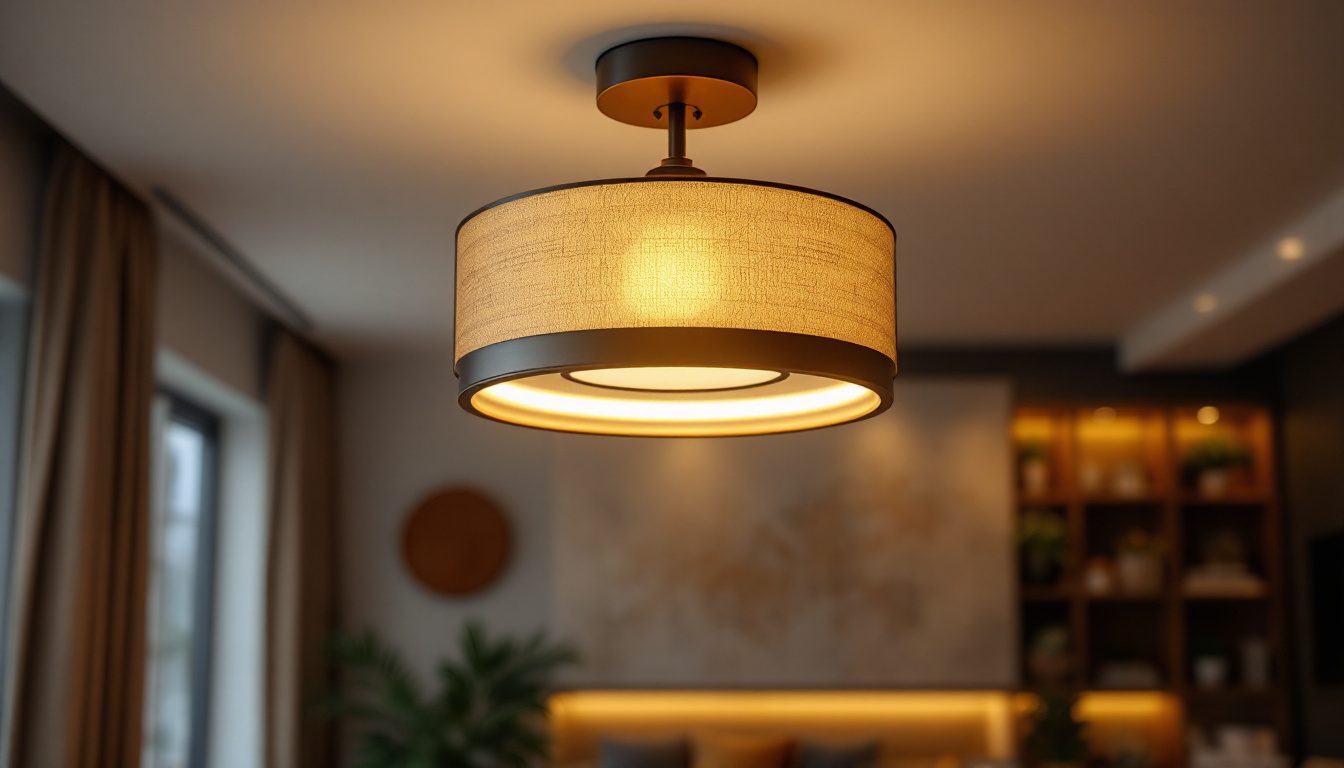
In the world of lighting design and installation, ceiling lights play a pivotal role in enhancing both functionality and aesthetics. Whether for residential, commercial, or industrial spaces, the right ceiling lights can transform an environment, creating the desired ambiance while ensuring adequate illumination. This article explores the importance of ceiling lights, the various types available, and how to select the best options for successful lighting projects.
Ceiling lights are often the primary source of illumination in a space, making them essential for any lighting project. They not only provide necessary light but also contribute significantly to the overall design of a room. The right ceiling lights can highlight architectural features, create focal points, and influence the mood of a space. For instance, a well-placed ceiling fixture can draw attention to a beautiful piece of artwork or an intricate ceiling design, enhancing the visual appeal of the room.
Moreover, ceiling lights can enhance safety and functionality. In commercial settings, proper lighting is crucial for visibility and productivity. In residential areas, it can help prevent accidents and create a welcoming atmosphere. Thus, selecting the right ceiling lights is not just about aesthetics; it’s about ensuring a safe and functional environment. The importance of ceiling lights extends beyond mere illumination; they can also affect how people feel in a space. Bright, cool lighting may energize a workspace, while warm, dim lighting can create a cozy and relaxing environment in a living room.
There are several types of ceiling lights available, each serving different purposes and styles. Understanding these types can help contractors make informed decisions for their projects. Additionally, the choice of ceiling light can significantly influence the energy efficiency of a space. LED options, for example, not only provide excellent illumination but also consume less energy, making them a sustainable choice for both residential and commercial applications.
Flush Mount Lights are designed to sit directly against the ceiling, providing a clean and streamlined look. They are ideal for rooms with low ceilings, as they do not protrude and can maximize headroom. Available in various styles and finishes, flush mount lights can complement any decor, from modern to traditional. They are particularly useful in hallways and smaller rooms where space is at a premium, ensuring that every corner is well-lit without overwhelming the design of the room.
Chandeliers are a statement piece in any room, often associated with elegance and luxury. They come in various designs, from intricate crystal fixtures to minimalist metal designs. Chandeliers can serve as a focal point in dining rooms or entryways, providing both light and style. Beyond their aesthetic appeal, chandeliers can also be equipped with dimmers, allowing for adjustable lighting that can set the mood for different occasions, whether it’s an intimate dinner or a lively gathering.
pendant lights hang from the ceiling and are versatile in their application. They can be used individually or in clusters to create a dramatic effect. Commonly found over kitchen islands or dining tables, pendant lights can add character and warmth to a space. Furthermore, the variety of shapes, sizes, and materials available means that pendant lights can be tailored to fit any design scheme, from rustic farmhouse to sleek industrial. The ability to mix and match these fixtures can also lead to unique and personalized lighting designs that truly reflect the homeowner’s style.
Selecting the appropriate ceiling lights for a project involves considering several factors, including the space’s purpose, size, and overall design aesthetic. Each of these elements plays a crucial role in achieving the desired lighting effect.
Before selecting ceiling lights, it is essential to assess the space where they will be installed. Consider the room’s size, shape, and existing decor. For larger spaces, multiple fixtures may be necessary to ensure adequate illumination. Conversely, smaller rooms may require only a single light source.
Additionally, the ceiling height can influence the choice of fixtures. In rooms with high ceilings, larger or more dramatic fixtures may be appropriate, while lower ceilings may necessitate flush mount or low-profile designs. It’s also worth noting that the layout of the room can affect how light is distributed. Open-concept spaces may benefit from strategically placed ceiling lights that create zones of light, guiding the eye and enhancing the flow of the area.
Different areas of a home or commercial space require varying levels of illumination. For instance, task-oriented areas like kitchens and workspaces need brighter lighting, while living rooms and bedrooms benefit from softer, ambient lighting. Understanding these needs can guide the selection of ceiling lights that provide the right balance of brightness.
Moreover, the color temperature of the light bulbs used in ceiling fixtures can significantly impact the mood of the space. Warmer tones create a cozy atmosphere, ideal for relaxation, while cooler tones can enhance focus and productivity in workspaces. Therefore, selecting the right bulb in conjunction with the fixture can elevate the overall functionality of the lighting design.
The style of ceiling lights should complement the overall design theme of the space. Whether opting for a modern, industrial, or classic look, the chosen fixtures should blend seamlessly with the existing decor. This consideration not only enhances the aesthetic appeal but also ensures a cohesive design throughout the project.
Incorporating unique materials and finishes can further personalize the lighting design. For example, a rustic wooden chandelier can add warmth to a farmhouse-style kitchen, while sleek metallic fixtures can enhance the contemporary feel of a minimalist living room. Additionally, considering the scale and proportion of the fixtures in relation to the room’s dimensions is vital; oversized fixtures can serve as a stunning focal point, while smaller ones can provide subtle elegance without overwhelming the space.
In today’s environmentally conscious world, energy efficiency is a crucial factor in selecting ceiling lights. With advancements in lighting technology, options such as LED fixtures have become increasingly popular due to their energy-saving capabilities and longevity.
LED ceiling lights consume significantly less energy compared to traditional incandescent bulbs, leading to lower electricity bills and reduced carbon footprints. Additionally, they have a longer lifespan, which means less frequent replacements and less waste. This makes LED fixtures an excellent choice for both residential and commercial lighting projects.
Smart ceiling lights offer an innovative approach to lighting control. These fixtures can be integrated with home automation systems, allowing users to adjust brightness, color temperature, and even schedules through mobile apps or voice commands. This flexibility not only enhances convenience but also promotes energy savings by allowing users to turn off lights remotely or set them to operate only when needed.
Proper installation of ceiling lights is vital for both safety and functionality. It is essential for contractors to follow best practices to ensure that the fixtures are securely mounted and that electrical connections are safe and compliant with local codes.
Before installation, contractors should assess the electrical requirements of the chosen ceiling lights. This includes understanding the wattage and voltage specifications, as well as ensuring that the existing wiring can support the new fixtures. In some cases, upgrading the electrical system may be necessary to accommodate higher wattage fixtures or to install additional lights.
The placement of ceiling lights significantly affects the overall lighting quality in a space. For example, in a kitchen, task lighting should be positioned above work areas, while ambient lighting should be evenly distributed throughout the room. Proper layout ensures that there are no dark spots and that the light is effectively utilized.
As design trends evolve, so do the styles and technologies associated with ceiling lights. Staying updated on the latest trends can help contractors offer clients innovative solutions that enhance their spaces.
Minimalism continues to be a popular trend in interior design, and ceiling lights are no exception. Simple, clean lines and understated designs are favored for their ability to blend seamlessly into various decor styles. These fixtures often focus on functionality while maintaining an elegant appearance.
Industrial and vintage-inspired ceiling lights are making a comeback, appealing to those who appreciate a rustic or retro aesthetic. These designs often feature exposed bulbs, metal finishes, and unique shapes that add character to a space. They can serve as eye-catching focal points while providing adequate illumination.
Colorful ceiling lights and customizable fixtures are gaining popularity as homeowners and designers look for ways to express individuality. From vibrant pendant lights to adjustable color temperature options, these choices allow for personalization and creativity in lighting design.
Ceiling lights are an essential component of successful lighting projects, offering both functionality and style. By understanding the various types of ceiling lights, assessing space requirements, and considering energy efficiency, contractors can make informed decisions that meet the needs of their clients.
As trends continue to evolve, staying updated on the latest designs and technologies will ensure that lighting professionals remain competitive in the industry. Ultimately, the right ceiling lights can transform a space, creating a welcoming and functional environment that enhances the overall experience for occupants.
Ready to elevate your lighting projects with the perfect ceiling lights? At LumenWholesale, we offer an extensive selection of top-quality, spec-grade lighting products that will meet and exceed your project needs. Our commitment to unbeatable wholesale prices means you get the best value without the middleman markups. Plus, with free shipping on bulk orders, you can trust that you’re getting premium lighting solutions at the most competitive prices. Don’t compromise on quality or cost—choose LumenWholesale for a seamless blend of affordability, reliability, and convenience. Wholesale Lighting at the Best Value is just a click away. Transform your space with LumenWholesale today.

Discover how LED Quasar technology is transforming the lighting industry with real-world success stories from contractors.

Explore the essential insights on sodium vapor light bulbs tailored for lighting contractors.

Discover the vital role power supply cords play in lighting projects with our essential guide for contractors.

Discover the comprehensive guide to metal halide bulbs tailored for lighting contractors.